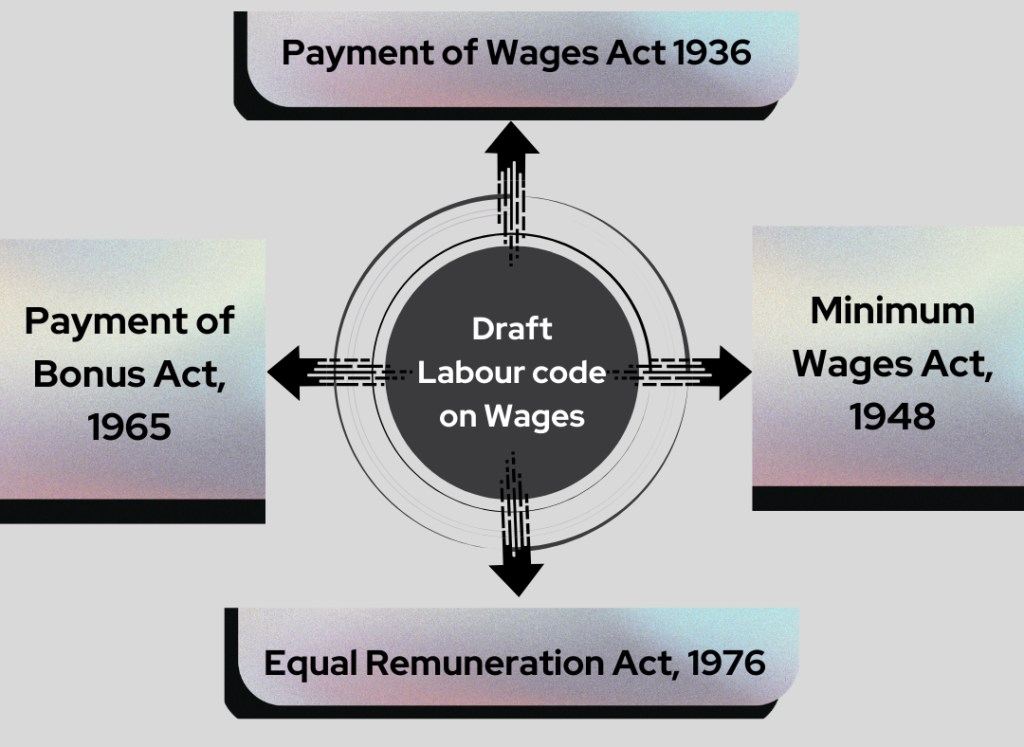Introduction:

The Equal Remuneration Act of 1976 is a significant labour law in India designed to promote gender equality in the workforce by ensuring that both men and women are paid equally for equal work or work of a comparable nature. This legislation is instrumental in advancing the rights of women and fostering a more inclusive and fair employment environment across the country.
Equal pay for equal work article 39 under Indian constitution:
Article 39 of the Constitution of India outlines the directive principles of state policy, focusing on social and economic justice. Although it does not grant enforceable rights, it assists the state in developing policies to benefit the citizens.

“The State shall, in particular, direct its policy towards securing—” reads Article 39.
- Article 39 states that “the State shall, in particular, direct its policy towards securing—”
- (a) that all citizens, regardless of gender, are entitled to a sufficient means of subsistence;
- (b) that the community’s material resources are owned and managed in a way that best serves the interests of the whole;
- (c) that the way the economy functions prevents wealth and production resources from becoming concentrated to the detriment of everyone.
- (d) that men and women receive equal compensation for equivalent labour;
- (e) that people do not abuse the strength and health of laborers, either men or women, or young children, and that people are not compelled to pursue occupations that are not a good fit for them due to financial necessity.
- (f) that childhood and youth are safeguarded against exploitation and against moral and material abandonment, and that children are provided with the means and opportunities to develop in a healthy way, in conditions of freedom and dignity.”
- The state is expressly required by Article 39(d) to ensure equal compensation for equal labour for men and women. This clause emphasizes the importance of gender equality in the workplace and establishes the principle of wage equality regardless of gender.
- Although Article 39(d) cannot be directly enforced in court, it serves as a foundational element for laws and policies that support equitable compensation practices and gender parity in the workplace.
Key Objectives of Equal Remuneration Act:
There are some salient features of equal remuneration act 1976:

Historical Context of Equal Remuneration Act:
The Equal Remuneration Act, 1976, was introduced in response to significant social and economic transformations in India, along with the global push for gender equality. The wages Act was influenced by various factors:
Provisions in Equal Remuneration Act
The Equal Remuneration Act of 1976 encompasses a range of provisions aimed at ensuring that men and women receive equal pay for performing the same work or work of a similar nature.
The wages Act consists of several key provisions:
Inspections and Compliance under Equal Remuneration Act
The Equal Remuneration Act of 1976 has the objective of ensuring that employees are paid equally for the same work. However, unlike other Indian labour laws, it does not explicitly outline inspection procedures or compliance mechanisms. Nevertheless, there are measures in place to monitor compliance and address violations of the wages act.
Here is an overview of how inspections and compliance are managed:

Government agencies in charge of labour and employment can organize awareness campaigns, workshops, and training programs to educate employers, employees, and the public about the Equal Remuneration Act.
These efforts are aimed at fostering comprehension and labour laws compliance in India with the principles of the Act. It is important to note that the Act strives to guarantee gender equality in pay and forbids any kind of discrimination against women in the workplace.
Forms in equal remuneration act India:

Form D under the Equal Remuneration Act, 1976, is related to the submission of an annual report by employers to the appropriate authority. This form is required to be filled out and submitted by certain employers as per the provisions of the wages Act.
Equal remuneration act 1976 rules:

The Equal Remuneration Act of 1976 is an Indian legislation that aims to prevent gender-based discrimination in employment and wages. To ensure its effective implementation, detailed guidelines have been established under this Act.
Here are some important rules that fall under the Equal Remuneration Act of 1976:
Amendments to the Equal Remuneration Act, 1976
- The 1987 Amendment:
- Clarified the scope of “remuneration” to include basic wages, dearness allowance, and other allowances.
- Expanded the coverage of provisions related to recruitment and conditions of employment to prevent discrimination.
- The Equal Remuneration (Amendment) Rules, 1996:
- Introduced more robust mechanisms for addressing complaints of discrimination.
- Strengthened the powers of inspectors to enforce compliance.
Key Provisions Integrated into the Code on Wages, 2019
The Code on Wages, 2019, which consolidates several labor laws, repealed the Equal Remuneration Act, 1976. Key provisions of the Act are now subsumed under the Code:
- Equal Pay for Equal Work:
- Sections of the Code explicitly prohibit discrimination based on gender in matters related to wages for similar work.
- Defines “similar work” as work requiring similar skill, effort, experience, and responsibility under similar working conditions.
- Prohibition of Discrimination in Recruitment:
- Prohibits gender-based discrimination in recruitment and employment opportunities.
- Applicability:
- The Code extends the principles of equal pay and non-discrimination to all employees in organized and unorganized sectors.
- Penalties:
- Enhanced penalties for non-compliance, ensuring stricter enforcement mechanisms.
Other Developments:
- Supreme Court Judgments:
- Various judgments have reinforced the principles of equal pay for equal work, making it a part of Article 14 and Article 39(d) of the Constitution.
- Examples include rulings that expanded the interpretation of “equal work” to include contractual workers and temporary employees.
- International Conventions:
- India’s obligations under the International Labour Organization (ILO) conventions on equal remuneration influenced amendments and the integration of gender equality principles into broader labor laws.
The Equal Remuneration Act FAQs:-
How does The Equal Remuneration Act contribute to gender equality in the workplace?
Answer: The Act ensures that women receive equal pay for equal work, eliminating wage disparity based on gender. By enforcing fair wages, it helps close the gender pay gap, creating a more equitable and inclusive work environment.
What actions should employers take to comply with The Equal Remuneration Act?
Answer: Employers should conduct regular salary audits, ensure equal pay for employees doing the same work, and develop policies that promote gender equality. Training and awareness programs can also help maintain compliance with the Act.
Can employees file complaints under The Equal Remuneration Act?
Answer: Yes, employees can file complaints if they believe they are being paid unequally for similar work. Complaints can be submitted to the appropriate authorities or labour courts for resolution under the Act.
Does The Equal Remuneration Act apply to all sectors?
Answer: Yes, the Equal Remuneration Act applies to all sectors, including industrial, commercial, and agricultural establishments. It covers all types of work in both the private and public sectors where men and women are doing similar work.
What are the penalties for non-compliance with The Equal Remuneration Act?
Answer: Employers who fail to comply with the provisions of the Act, such as paying unequal wages for equal work, can face fines and imprisonment. The penalties are aimed at enforcing gender pay equality and deterrence against discrimination.
Are there any exceptions under The Equal Remuneration Act for different wages based on gender?
Answer: Yes, the Act allows for exceptions based on factors like seniority, experience, and skill level. However, gender alone cannot be a basis for unequal pay for similar work.
What is The Equal Remuneration Act, 1976?
Answer: The Equal Remuneration Act, 1976 is an Indian labour law that mandates equal pay for men and women doing the same or similar work. It ensures that gender discrimination in wages is eliminated, promoting gender equality in the workplace.
What is the definition of “equal work” under The Equal Remuneration Act?
Answer: Under the Act, “equal work” refers to work that is of similar nature, skill, and responsibility. If two employees, regardless of gender, perform the same tasks or duties, they must receive the same remuneration.
Who is covered under The Equal Remuneration Act, 1976?
Answer: The Act applies to all employers and employees in organizations, including government and private sector businesses. It covers both skilled and unskilled workers who are engaged in similar or identical work.
What is the objective of The Equal Remuneration Act?
Answer: The primary objective of the Equal Remuneration Act is to provide equal pay for equal work, irrespective of gender, and to prevent discrimination in wages and other employment benefits for men and women performing the same job.
Summary of The Equal Remuneration Act:-
The Equal Remuneration Act 1976, stands as a crucial piece of legislation aimed at advancing gender equality in the workplace by ensuring fair and equal pay for both men and women. This act not only empowers women but also fosters inclusive and just employment practices across India.
Contact Us for any Labour Law Compliance
Stay compliant with essential labour laws. Explore comprehensive guidelines, compliance requirements, and expert advice. Ensure your business adheres to employment regulations and protects employee rights.

